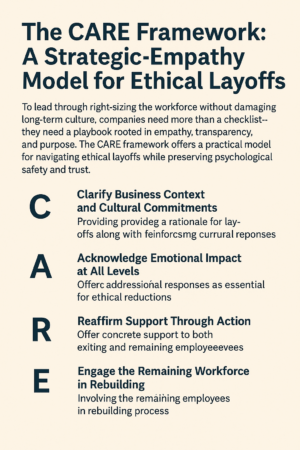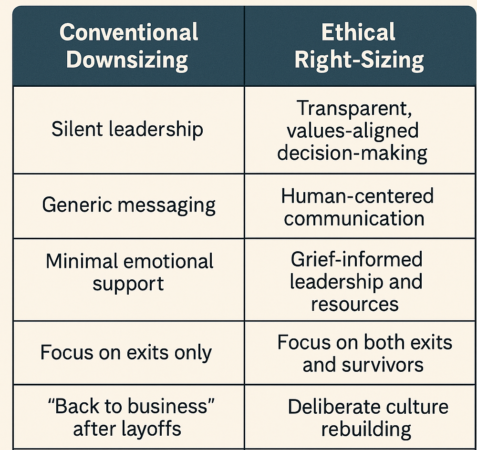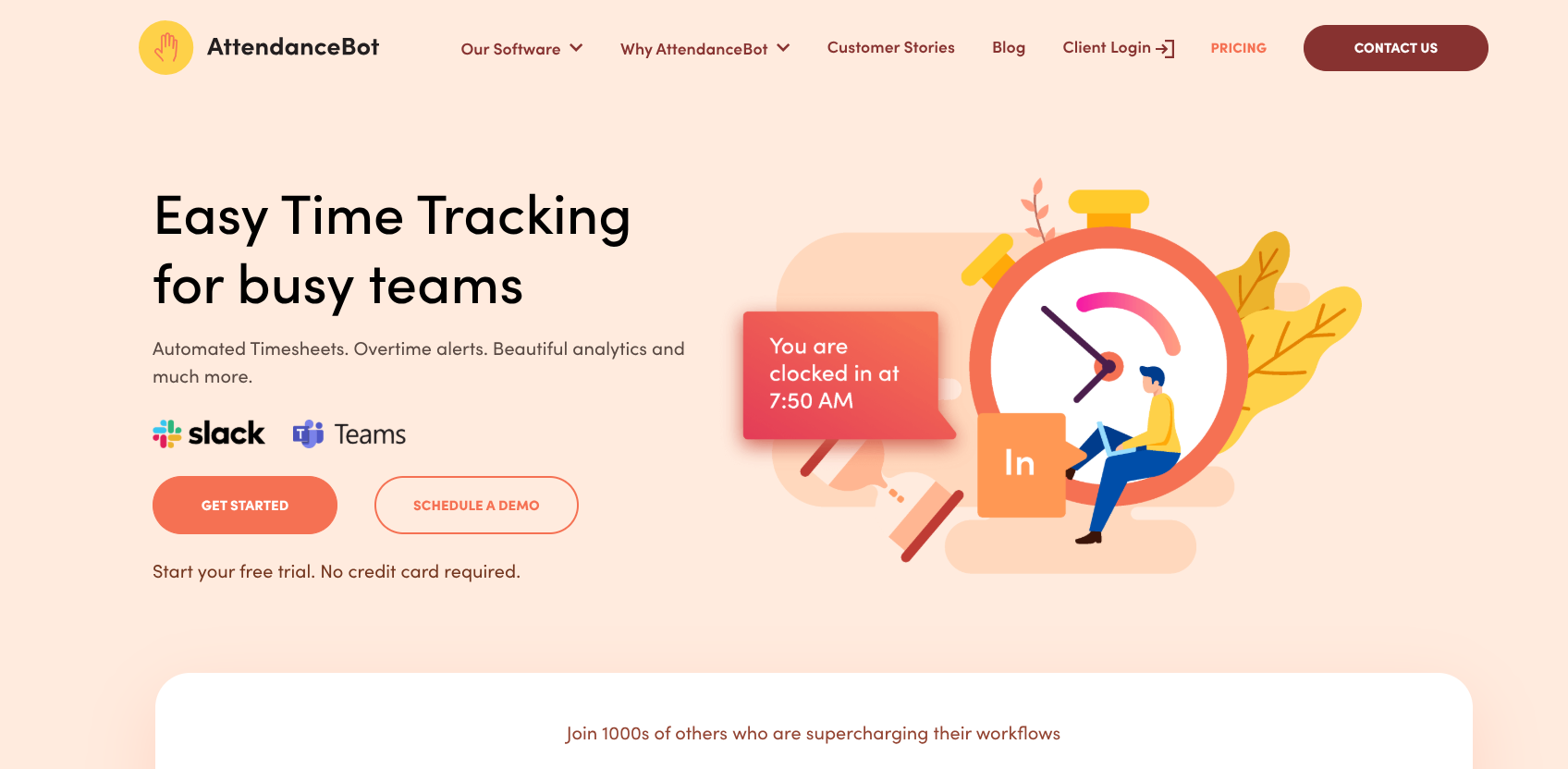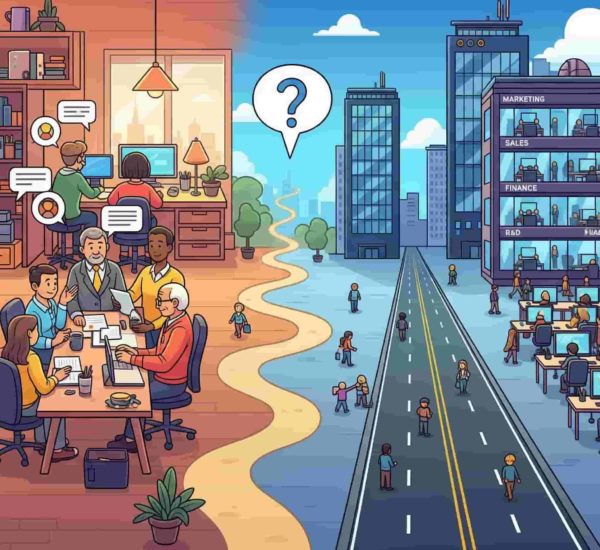When markets tighten or businesses shift direction, whether through automation, mergers, or evolving customer demands, tough decisions often follow. Among the most difficult is the need to reduce headcount. But while workforce reductions may be financially necessary, how they’re handled speaks volumes about an organization’s values. There’s a significant difference between a cost-cutting layoff and an ethical layoff. Done poorly, downsizing can damage morale, fracture trust, and create a lingering sense of survivor’s guilt. Done with care, right-sizing the workforce can preserve culture, maintain transparency, and reinforce the company’s long-term credibility.
In moments like these, the goal isn’t to soften reality; it’s to lead through it with integrity. This article explores the principles of humane right-sizing workforce, offering guidance on how to communicate with empathy, support both exiting and remaining employees, and rebuild stronger in the aftermath.
Key Principles of Ethical Layoffs: Leading With Empathy, Not Just Efficiency
Implementing ethical layoffs isn’t about putting a positive spin on a hard decision. It’s about honoring the dignity of every employee, whether they’re exiting or staying, and making sure the process reflects your company’s values as much as its business strategy.
Here are the foundational principles for navigating humane workforce downsizing while maintaining the cultural integrity of your organization:
1. Intentionality Over Urgency
When financial pressure is mounting, the instinct is to act quickly. But rushing through a right-sizing workforce process can lead to confusion, resentment, and irreversible cultural damage. Ethical decision-making means taking the time to weigh not only who is impacted, but also how and why.
Ask:
- Are we making decisions based on strategic necessity or short-term optics?
- Have we explored alternatives to layoffs (e.g., role reassignments, voluntary exits, reduced hours)?
Thoughtful action signals that leadership isn’t operating from panic but from principle.
2. Transparent, Timely Communication
Silence breeds fear, and half-truths undermine trust. One of the hardest but most important parts of humane workforce downsizing is communicating transparently, even when the message is difficult.
Best practices:
- Tell people early—ideally before rumors take over.
- Be clear about the “why” behind the decision, including business context and long-term goals.
- Avoid jargon. Use human language that respects the emotional weight of the moment.
Even those most impacted are more likely to accept difficult news when it’s delivered with honesty and humility.
3. Prioritize Dignity in the Exit Experience
An ethical layoff ensures that those leaving the company feel supported, not discarded. This includes:
- Personalized conversations, never mass emails, or cold HR handoffs
- Fair severance packages and transition support
- Clear information on benefits, references, and next steps
- Emotional support, such as access to counseling or career coaching
The exit process is often the last experience someone has with your company. Make it one that reflects your values, not your stress.
4. Support the Survivors
Layoffs don’t just impact those who leave. Employees who remain often experience guilt, anxiety, and disengagement—especially if the process felt cold or unclear.
To maintain morale:
- Hold open forums for questions and concerns
- Reiterate your commitment to culture and transparency
- Offer resources for mental health, workload management, and resilience-building
Retained employees need to see that empathy doesn’t stop once the layoffs are over—it becomes the lens through which recovery is led.
5. Rebuild With Intention
After a right-sizing workforce event, leaders often pivot too quickly into “business as usual.” But culture doesn’t bounce back without care. Post-reduction, organizations should:
- Re-establish team norms and psychological safety
- Recognize remaining employees’ contributions
- Clarify vision and purpose moving forward
- Use tools like AttendanceBot to track engagement patterns, flag burnout risks, and support team communication
Downsizing may reduce numbers, but it shouldn’t reduce humanity. Investing in recovery ensures the culture you fought to protect doesn’t unravel after the fact.
The CARE Framework: A Strategic-Empathy Model for Ethical Layoffs

To lead through right-sizing the workforce without damaging long-term culture, companies need more than a checklist—they need a playbook rooted in empathy, transparency, and purpose. The CARE framework offers a practical model for navigating ethical layoffs while preserving psychological safety and trust.
C – Clarify Business Context and Cultural Commitments
Start by providing a clear business rationale for the workforce reduction—whether it’s market contraction, automation, or a pivot in strategy. But don’t stop there. Reinforce your cultural values so employees understand that the decision, though difficult, is grounded in principle.
- Why it matters: According to Harvard Business Review, employees are far more likely to accept layoffs when they understand the “why” and see that leadership is transparent and values-driven.
- Best practice: Communicate both the short-term necessity and the long-term vision. For example, “We are reducing headcount by 12% to stay financially stable in 2025 and reinvest in AI-based service lines—ensuring we’re still here, and competitive, five years from now.”
A – Acknowledge Emotional Impact at All Levels
Leadership often underestimates the ripple effects of layoffs. It’s not just about who leaves—it’s also about who stays. Survivor guilt, fear, and disengagement are real, and if unaddressed, they can tank morale and productivity.
- Many studies emphasize that addressing emotional responses is a crucial part of ethical workforce reduction. Leaders must create safe spaces for grief, anger, and anxiety.
- How to do it well: Facilitate open forums, provide access to mental health resources, and train managers to lead with emotional intelligence. Don’t treat emotions as an HR afterthought—they’re central to the process.
R – Reaffirm Support Through Action
Words matter, but actions stick. Ethical organizations don’t stop at severance, they offer concrete support for departing and remaining employees alike.
- For those exiting: Provide individualized notifications (not cold mass emails), career counseling, resume and interview prep, and extended access to benefits when possible.
- For those staying: Be clear about what comes next. Use tools like AttendanceBot to monitor burnout, absenteeism, or workload imbalance. This shows you’re paying attention to employee wellbeing post-layoff, not just performance.
E – Engage the Remaining Workforce in Rebuilding
After a humane workforce downsizing, it’s tempting to go “back to normal.” But culture doesn’t bounce back by default—it requires intentional rebuilding.
- McKinsey research shows that when organizations involve employees in shaping the new structure and clarify expectations quickly, post-restructuring retention improves significantly. (Source)
- Your next steps: Co-create team rituals, clarify roles, and revisit purpose. Consider launching a “culture recalibration” effort that includes surveys, listening tours, or new recognition systems.
What Makes Ethical Layoffs Stand Apart

The Survivor Syndrome: What Happens to Those Who Stay
Layoffs don’t only affect those who leave; those who remain often carry a heavy emotional and psychological load. This phenomenon is known as “survivor syndrome”, and it can significantly affect morale, productivity, and trust.
Employees who remain after layoffs frequently report feelings of guilt, anxiety, resentment, and disconnection. Without proactive support, they may disengage, burn out, or quietly exit later—a costly ripple effect for any organization.
Warning signs of survivor syndrome:
- Increased absenteeism or time-off requests
- Declining engagement or collaboration
- Drop in discretionary effort or output
- Frustration about unclear new roles or increased workloads
Strategies to address it:
- Acknowledge the loss openly, don’t pretend nothing happened.
- Offer facilitated team conversations or listening sessions.
- Re-establish clarity around team goals and priorities.
- Utilize tools like AttendanceBot to monitor burnout indicators (e.g., excessive time off use, missed check-ins, or low engagement on Slack or Teams).
Supporting your remaining workforce isn’t optional; it’s essential to cultural recovery.
Real-World Examples: Companies That Did It Right
Some organizations have managed to balance business imperatives with humanity. These examples show that ethical layoffs are possible—and can even strengthen a company’s reputation when handled transparently.
Airbnb (2020)
Faced with massive COVID-19 revenue losses, Airbnb laid off 25% of its workforce. But CEO Brian Chesky’s layoff memo became a masterclass in compassionate communication:
- Personalized support and extended healthcare
- Alumni talent directory to help people get rehired
- A tone of humility, gratitude, and deep care
The result? Employees praised the company’s integrity, and Airbnb’s employer brand emerged stronger, even after a painful reduction.
When Not to Lay Off: Exploring Alternatives to Workforce Reductions
Layoffs should be the last resort, not the go-to solution. Before pulling the trigger on workforce reductions, forward-thinking companies explore alternatives that maintain employment while protecting long-term viability.
Viable alternatives to layoffs:
- Voluntary unpaid leave or reduced hours: Ask for volunteers to take time off or shift to part-time.
- Redeployment or reskilling: Move employees to departments that are growing or invest in upskilling for new functions.
- Job sharing: Two employees split the responsibilities and pay of one full-time role.
- Temporary pay cuts with executive leadership taking the lead: Communicates solidarity and shared sacrifice.
- Furloughs: Pause work and pay without permanent separation.
Ethical layoffs are sometimes unavoidable, but thoughtful leaders first exhaust other paths. Choosing alternatives not only preserves jobs, it preserves trust.
Building a Cultural Recovery Plan: 30, 60, 90 Days Post-Layoff
After a workforce reduction, the hard decisions may be over, but the real work of cultural healing is just beginning. A well-structured 30-60-90 day recovery roadmap can help leaders stabilize morale, rebuild trust, and reestablish team clarity without losing momentum.
Organizational research from McKinsey & Company highlights that post-change performance hinges not on speed alone, but on clarity, communication, and consistent follow-through.
🔹 First 30 Days: Acknowledge and Stabilize
- Host listening tours with senior leaders and mid-managers to create space for feedback and emotions.
- Clarify the “why” behind the reduction again, consistently and transparently.
- Re-onboard remaining employees: Realign on mission, values, and what’s changing.
- Monitor burnout risk via time-off trends or productivity dips using tools like AttendanceBot.
Tip: Don’t assume silence means everything is okay. Silence often signals disengagement or mistrust.
🔹 Next 30 Days (Days 31–60): Reconnect and Rebuild
- Launch team retrospectives: What do people need to feel supported again?
- Realign goals: With leaner teams, prioritize what matters most.
- Create cross-functional micro-projects to foster renewed collaboration.
- Restart feedback loops: Bi-weekly pulse surveys or manager 1:1s are crucial now.
During this period, transparency is your greatest asset. As McKinsey puts it, “Organizational health improves when people see their input is acted upon, not ignored.”
🔹 Final 30 Days (Days 61–90): Re-energize and Reinforce
- Celebrate visible wins, even small ones—it shows forward progress.
- Revisit role clarity: Ensure people know where they fit and why they matter.
- Offer development opportunities: Learning programs signal investment, not austerity.
- Reinforce leadership visibility: Executives should remain present and emotionally accessible.
By day 90, the organization should begin showing signs of cultural stability—but that doesn’t mean the work ends. Ongoing rituals of communication, recognition, and listening must remain embedded long-term.
Final Thought on Right-Sizing the Workforce
Executing ethical layoffs isn’t about softening the blow; it’s about doing what’s right, even when it’s hard. It’s a long game. And those who approach right-sizing the workforce with empathy and structure will be the ones with cultures that not only survive but emerge stronger.
If you’re looking to support your team post-reduction, tools like AttendanceBot can help HR and People teams track morale trends, improve workload visibility, and foster better team communication during uncertain transitions.




